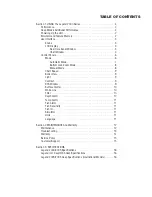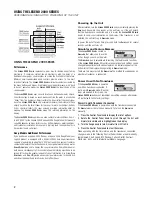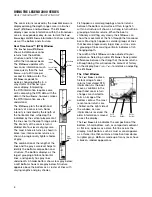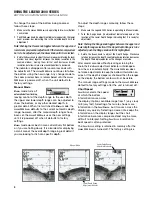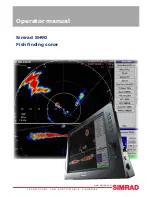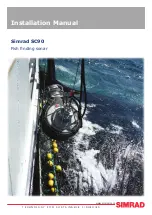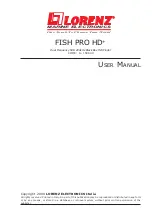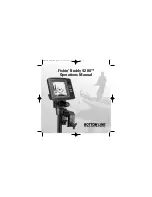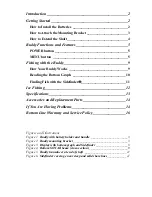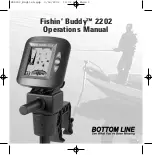
2. The unit starts up in Simulator mode.
The
L
EGEND
2000 S
ERIES
has the ability to detect that a
transducer is connected. If, at power up, a transducer
is not connected, the unit starts up in
S
IMULATOR
mode.
Ensure that an appropriate transducer connector is
used and the connector is positioned correctly in the
collector plug. Also, be sure that the collector plug is
fully-seated into the unit. Next, inspect the transducer
cable from end to end for breaks, kinks, or cuts in the
outer casing of the cable, and repair after
disconnecting the cable from both the unit and the
transducer. Also, make sure that the transducer is fully
submerged in water. If the transducer is connected to
the unit through a switch, temporarily connect it
directly to the unit and try again. If none of these
items identifies an obvious problem, the transducer
itself may be at fault. Be sure to include the
transducer if returning the unit for repair.
To override the
S
IMULATOR
manually, select the
S
IMULATOR
C
ONTROL
P
ANEL
and turn to
O
FF
. See Control Panels for
more information.
3. There is no bottom reading visible on the display.
There are several possible causes for this condition. If
the loss of bottom information occurs only at high
boat speeds, the transducer needs to be adjusted. If
the digital depth readout is working but there is no
bottom visible on-screen, it is possible that the depth
range has been adjusted manually to a range lower
than that needed to display the bottom. Also, in very
deep water, it may be necessary to increase the
G
AIN
setting manually in order to maintain a graphic
depiction of the bottom.
If you are using a transducer switch to connect two
transducers to the
L
EGEND
2000 S
ERIES
, make sure that the
switch is in the correct position to connect a
transducer, and that the transducer is submerged in
water. (If a trolling motor transducer is selected and
the trolling motor is out of the water, no sonar
information will appear.)
If none of the above solves the problem, inspect the
transducer cable from end to end for breaks, kinks, or
cuts in the outer casing of the cable, and repair after
disconnecting the cable from both the unit and the
transducer. If the transducer is connected to the unit
through a switch, temporarily connect it directly to the
unit and try again. If none of these items identifies an
obvious problem, the transducer itself may be at fault.
Be sure to include the transducer if returning the unit
for repair.
4. When in very shallow water, I get gaps in the bottom
reading and inconsistent digital depth indications.
The
L
EGEND
2000 S
ERIES
will work reliably in water 2' (.6m) or
deeper. Remember that the depth is measured from the
transducer, not necessarily from the surface of the water.
5. The unit comes on before I press POWER, and won’t turn off.
Check the transducer cable—if the outer jacket of the cable has been cut
and the cable is in contact with bare metal, you need to disconnect the
cable from the unit, then repair the cut with electrical tape. If there is no
problem with the cable, disconnect the transducer from the unit and see if
the problem is corrected, to isolate the source of the problem.
6. I get gaps in the reading at high speeds.
Your transducer needs to be adjusted. If the transducer is transom-
mounted, there are two adjustments available to you: height and running
angle. Make small adjustments and run the boat at high speeds to
determine the effect. It may take several tries to optimize high speed
operation. This can also be a result of air or turbulence in the transducer
location caused by rivets, ribs, etc.
7. My unit loses power at high speeds.
Your
L
EGEND
2000 S
ERIES
has over-voltage protection that turns the unit off
when input voltage exceeds 20 VDC. Some outboard motors do not
regulate the power output of the engine’s alternator effectively and can
produce voltage in excess of 20 volts when running at high RPMs. The
L
EGEND
2000 S
ERIES
displays input voltage in the lower left corner of the
display when it exceeds 15 VDC. Use this readout to determine if the
voltage exceeds 20 VDC.
8. The screen begins to fade out. Images are not as sharp
as normal.
Check the input voltage. The
L
EGEND
2000 S
ERIES
will display the current
voltage on-screen if it is greater than 16 or less than 10 VDC. The voltage
readout will appear in the bottom left corner of the screen.
9. The display shows many black dots at high speeds and high
sensitivity settings.
You are seeing noise or interference caused by one of several sources.
Noise can be caused by other electronic devices. Turn off any nearby
electronics and see if the problem goes away. Noise can also be caused
by the engine. If engine noise is causing the interference, the problem will
intensify at higher RPMs. Increase the engine speed with the boat
stationary to isolate this cause. Propeller cavitation can appear as noise
on-screen. If the transducer is mounted too close to the propeller, the
turbulence generated can interfere with the sonar signal. Ensure that the
transducer is mounted at least 15" (380 mm) from the prop.
10. The screen does not display a full fish arch.
Check the running angle of the transducer. If the running angle is too
great, a full fish arch may not appear. Reduce the running angle of the
transducer. Several incremental adjustments may be necessary.
13
MAINTENANCE AND WARRANTY
TROUBLESHOOTING



